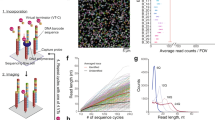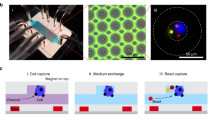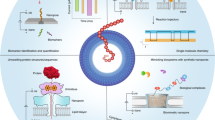Abstract
Massively parallel DNA sequencing is established, yet high-throughput protein profiling remains challenging. Here, we report a barcoding approach that leverages the combinatorial sequence content and the configurational programmability of DNA nanostructures for high-throughput multiplexed profiling of the subcellular expression and distribution of proteins in whole cells. The barcodes are formed by in situ hybridization of tetrahedral DNA nanostructures and short DNA sequences conjugated with protein-targeting antibodies, and by nanostructure-assisted ligation (either enzymatic or chemical) of the nanostructures and exogenous DNA sequences bound to nanoparticles of different sizes (which cause these localization sequences to differentially distribute across subcellular compartments). Compared with linear DNA barcoding, the nanostructured barcodes enhance the signal by more than 100-fold. By implementing the barcoding approach on a microfluidic device for the analysis of rare patient samples, we show that molecular subtypes of breast cancer can be accurately classified and that subcellular spatial markers of disease aggressiveness can be identified.
This is a preview of subscription content, access via your institution
Access options
Access Nature and 54 other Nature Portfolio journals
Get Nature+, our best-value online-access subscription
$29.99 / 30 days
cancel any time
Subscribe to this journal
Receive 12 digital issues and online access to articles
$99.00 per year
only $8.25 per issue
Buy this article
- Purchase on Springer Link
- Instant access to full article PDF
Prices may be subject to local taxes which are calculated during checkout





Similar content being viewed by others
Data availability
The authors declare that the main data supporting the results in this study are available within the paper and its Supplementary Information. The raw and analysed datasets generated during the study are available for research purposes from the corresponding author on reasonable request.
References
Borrebaeck, C. A. Precision diagnostics: moving towards protein biomarker signatures of clinical utility in cancer. Nat. Rev. Cancer 17, 199–204 (2017).
Landegren, U., Al-Amin, R. A. & Björkesten, J. A myopic perspective on the future of protein diagnostics. New Biotechnol. 45, 14–18 (2018).
Klein, A. M. et al. Droplet barcoding for single-cell transcriptomics applied to embryonic stem cells. Cell 161, 1187–1201 (2015).
De Vlaminck, I. et al. Noninvasive monitoring of infection and rejection after lung transplantation. Proc. Natl Acad. Sci. USA 112, 13336–13341 (2015).
Hughes, A. J. et al. Single-cell western blotting. Nat. Methods 11, 749–755 (2014).
Yamauchi, K. A. & Herr, A. E. Subcellular western blotting of single cells. Microsyst. Nanoeng. 3, 16079 (2017).
Thul, P. J. et al. A subcellular map of the human proteome. Science 356, eaal3321 (2017).
Adan, A., Alizada, G., Kiraz, Y., Baran, Y. & Nalbant, A. Flow cytometry: basic principles and applications. Crit. Rev. Biotechnol. 37, 163–176 (2017).
Tighe, P. J., Ryder, R. R., Todd, I. & Fairclough, L. C. ELISA in the multiplex era: potentials and pitfalls. Proteom. Clin. Appl. 9, 406–422 (2015).
Foster, L. J. et al. A mammalian organelle map by protein correlation profiling. Cell 125, 187–199 (2006).
Kingsmore, S. F. Multiplexed protein measurement: technologies and applications of protein and antibody arrays. Nat. Rev. Drug Discov. 5, 310–320 (2006).
Nong, R. Y., Gu, J., Darmanis, S., Kamali-Moghaddam, M. & Landegren, U. DNA-assisted protein detection technologies. Expert Rev. Proteom. 9, 21–32 (2012).
Fredriksson, S. et al. Multiplexed protein detection by proximity ligation for cancer biomarker validation. Nat. Methods 4, 327–329 (2007).
Burns, T. J. et al. High-throughput precision measurement of subcellular localization in single cells. Cytom. A 91, 180–189 (2017).
Goltsev, Y. et al. Deep profiling of mouse splenic architecture with CODEX multiplexed imaging. Cell 174, 968–981 (2018).
Boutorine, A. S., Novopashina, D. S., Krasheninina, O. A., Nozeret, K. & Venyaminova, A. G. Fluorescent probes for nucleic acid visualization in fixed and live cells. Molecules 18, 15357–15397 (2013).
Kazane, S. A. et al. Site-specific DNA-antibody conjugates for specific and sensitive immuno-PCR. Proc. Natl Acad. Sci. USA 109, 3731–3736 (2012).
Rosen, C. B. et al. Template-directed covalent conjugation of DNA to native antibodies, transferrin and other metal-binding proteins. Nat. Chem. 6, 804–809 (2014).
Gu, L. et al. Multiplex single-molecule interaction profiling of DNA-barcoded proteins. Nature 515, 554–557 (2014).
Agasti, S. S., Liong, M., Peterson, V. M., Lee, H. & Weissleder, R. Photocleavable DNA barcode–antibody conjugates allow sensitive and multiplexed protein analysis in single cells. J. Am. Chem. Soc. 134, 18499–18502 (2012).
Kwak, M. & Herrmann, A. Nucleic acid/organic polymer hybrid materials: synthesis, superstructures, and applications. Angew. Chem. Int. Edn. 49, 8574–8587 (2010).
Douglas, S. M. et al. Self-assembly of DNA into nanoscale three-dimensional shapes. Nature 459, 414–418 (2009).
Ke, Y., Ong, L. L., Shih, W. M. & Yin, P. Three-dimensional structures self-assembled from DNA bricks. Science 338, 1177–1183 (2012).
Li, Y. et al. Controlled assembly of dendrimer-like DNA. Nat. Mater. 3, 38–42 (2004).
Lin, C. et al. Submicrometre geometrically encoded fluorescent barcodes self-assembled from DNA. Nat. Chem. 4, 832–839 (2012).
Lee, H. et al. Molecularly self-assembled nucleic acid nanoparticles for targeted in vivo siRNA delivery. Nat. Nanotechnol. 7, 389–393 (2012).
Lin, M. et al. Programmable engineering of a biosensing interface with tetrahedral DNA nanostructures for ultrasensitive DNA detection. Angew. Chem. Int. Ed 54, 2151–2155 (2015).
Wang, L., Meng, Z., Martina, F., Shao, H. & Shao, F. Fabrication of circular assemblies with DNA tetrahedrons: from static structures to a dynamic rotary motor. Nucleic Acids Res. 45, 12090–12099 (2017).
Neve, R. M. et al. A collection of breast cancer cell lines for the study of functionally distinct cancer subtypes. Cancer Cell 10, 515–527 (2006).
Anglesio, M. S. et al. Type-specific cell line models for type-specific ovarian cancer research. PLoS ONE 8, e72162 (2013).
Bauer, R. J., Jurkiw, T. J., Evans, T. C. & Lohman, G. J. Rapid time scale analysis of T4 DNA Ligase-DNA binding. Biochemistry 56, 1117–1129 (2017).
Rossi, R., Montecucco, A., Ciarrocchi, G. & Biamonti, G. Functional characterization of the T4 DNA ligase: a new insight into the mechanism of action. Nucleic Acids Res. 25, 2106–2113 (1997).
Costantini, D. L., Bateman, K., McLarty, K., Vallis, K. A. & Reilly, R. M. Trastuzumab-resistant breast cancer cells remain sensitive to the Auger electron-emitting radiotherapeutic agent 111In-NLS-trastuzumab and are radiosensitized by methotrexate. J. Nucl. Med. 49, 1498–1505 (2008).
Uhlen, M. et al. Towards a knowledge-based human protein atlas. Nat. Biotechnol. 28, 1248–1250 (2010).
Im, H. et al. Label-free detection and molecular profiling of exosomes with a nano-plasmonic sensor. Nat. Biotechnol. 32, 490–495 (2014).
Blows, F. M. et al. Subtyping of breast cancer by immunohistochemistry to investigate a relationship between subtype and short and long term survival: a collaborative analysis of data for 10,159 cases from 12 studies. PLoS Med. 7, e1000279 (2010).
Maciejczyk, A. et al. Elevated nuclear S100P expression is associated with poor survival in early breast cancer patients. Histol. Histopathol. 28, 513–524 (2013).
van der Gun, B. T. et al. EpCAM in carcinogenesis: the good, the bad or the ugly. Carcinogenesis 31, 1913–1921 (2010).
Ralhan, R. et al. EpCAM nuclear localization identifies aggressive thyroid cancer and is a marker for poor prognosis. BMC Cancer 10, 331 (2010).
Schillaci, R. et al. Clinical relevance of ErbB-2/HER2 nuclear expression in breast cancer. BMC Cancer 12, 74 (2012).
Elizalde, P. V., Cordo Russo, R. I., Chervo, M. F. & Schillaci, R. ErbB-2 nuclear function in breast cancer growth, metastasis and resistance to therapy. Endocr. Relat. Cancer 23, T243–T257 (2016).
Chen, Y. J., Groves, B., Muscat, R. A. & Seelig, G. DNA nanotechnology from the test tube to the cell. Nat. Nanotechnol. 10, 748–760 (2015).
Seeman, N. C. & Sleiman, H. F. DNA nanotechnology. Nat. Rev. Mater. 3, 17068 (2017).
Pei, H., Zuo, X., Zhu, D., Huang, Q. & Fan, C. Functional DNA nanostructures for theranostic applications. Acc. Chem. Res. 47, 550–559 (2014).
Xie, N. et al. DNA tetrahedron nanostructures for biological applications: biosensors and drug delivery. Analyst 142, 3322–3332 (2017).
Fredriksson, S. et al. Protein detection using proximity-dependent DNA ligation assays. Nat. Biotechnol. 20, 473–477 (2002).
Wu, A. M. & Senter, P. D. Arming antibodies: prospects and challenges for immunoconjugates. Nat. Biotechnol. 23, 1137–1146 (2005).
Söderberg, O. et al. Direct observation of individual endogenous protein complexes in situ by proximity ligation. Nat. Methods 3, 995–1000 (2006).
Ryan, C. J. et al. High-resolution network biology: connecting sequence with function. Nat. Rev. Genet. 14, 865–879 (2013).
Gerber, D., Maerkl, S. J. & Quake, S. R. An in vitro microfluidic approach to generating protein-interaction networks. Nat. Methods 6, 71–74 (2009).
Li, J., Green, A. A., Yan, H. & Fan, C. Engineering nucleic acid structures for programmable molecular circuitry and intracellular biocomputation. Nat. Chem. 9, 1056–1067 (2017).
Ho, N. R. Y. et al. Visual and modular detection of pathogen nucleic acids with enzyme-DNA molecular complexes. Nat. Commun. 9, 3238 (2018).
Ren, K. et al. A DNA dual lock-and-key strategy for cell-subtype-specific siRNA delivery. Nat. Commun. 7, 13580 (2016).
Shao, H. et al. Chip-based analysis of exosomal mRNA mediating drug resistance in glioblastoma. Nat. Commun. 6, 6999 (2015).
Prakadan, S. M., Shalek, A. K. & Weitz, D. A. Scaling by shrinking: empowering single-cell ‘omics’ with microfluidic devices. Nat. Rev. Genet. 18, 345–361 (2017).
Acknowledgements
The authors thank Y. K. Sim, Y. P. Neo and C. Liu for experimental assistance, J. L.Y. Yap, R. Malathi and A. Franco-Obregón for assistance with clinical sample collection, NUH Tissue Repository for providing clinical samples and S. V. Sundararajan for device fabrication. This work was supported in part by funding from NUS Research Scholarship, Ministry of Education, National Medical Research Council, NUS iHealthtech, A*STAR IMCB Independent Fellowship and NUS Early Career Research Award.
Author information
Authors and Affiliations
Contributions
N.R.S. and H.S. designed the study, performed data analysis and wrote the manuscript. N.R.S., N.R.Y.H., G.S.L., A.N., X.D. and Y.L. performed the research. C.W.C. and T.P.L. provided clinical samples. J.E.S. provided pathology evaluation. All authors contributed to the manuscript.
Corresponding author
Ethics declarations
Competing interests
The authors declare no competing interests.
Additional information
Publisher’s note: Springer Nature remains neutral with regard to jurisdictional claims in published maps and institutional affiliations.
Supplementary Information
Supplementary Information
Supplementary figures and tables.
Rights and permissions
About this article
Cite this article
Sundah, N.R., Ho, N.R.Y., Lim, G.S. et al. Barcoded DNA nanostructures for the multiplexed profiling of subcellular protein distribution. Nat Biomed Eng 3, 684–694 (2019). https://doi.org/10.1038/s41551-019-0417-0
Received:
Accepted:
Published:
Issue Date:
DOI: https://doi.org/10.1038/s41551-019-0417-0
This article is cited by
-
Multiplex lateral flow test strip for detection of carbapenemase genes using barcoded tetrahedral DNA capture probe-based biosensing interface
Microchimica Acta (2023)
-
A hydrogel-based mechanical metamaterial for the interferometric profiling of extracellular vesicles in patient samples
Nature Biomedical Engineering (2022)
-
Cyclic microchip assay for measurement of hundreds of functional proteins in single neurons
Nature Communications (2022)
-
Extracellular vesicle drug occupancy enables real-time monitoring of targeted cancer therapy
Nature Nanotechnology (2021)
-
Nucleic Acids Analysis
Science China Chemistry (2021)



